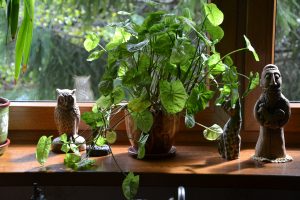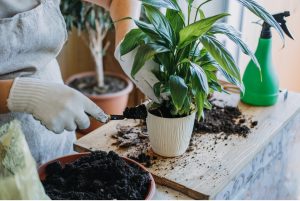We love summer, but sometimes the summer heat can be a little overwhelming. It’s the same for your indoor plants. Even when they are in an air-conditioned office or home, your indoor plants can suffer from the negative effects of summer heat. Don’t let your plants sweat it out this summer. Check out our summer indoor plant care tips.
Protect your indoor plants from strong summer rays

Don’t let your indoor plants get sunburned by strong sunlight through windows in the summer. Move them to a protected spot. Photo: Yanoch Kandreeva/Creative Commons License
You put on sunscreen to keep the sun’s strong summer rays from causing sunburn. You need to protect your plants from sunburn, too. No, they aren’t going to the beach, but they can get extra doses of hot summer sunlight through south and west facing windows. You may not realize it, especially if you aren’t in your home or office during hot parts of the day. Check the position of your plants, and move them into an area whey they won’t get direct sunlight during the summer months. This is true even for succulents and cacti inside that aren’t used to direct sun since the cell structure of shade grown plants is different than that of sun grown plants.
Keep growing conditions cool
Your indoor plants are a lot like you. They don’t like it when things heat up indoors during the summer. Here at Good Earth Plants, we like to keep our greenhouse at 60 to 85 degrees, so if you’re comfortable, so are they. Even if you have air conditioning, there are spots in your home or office that are hard to cool down. Make sure your plants aren’t sweating it out. Move them into cooler rooms if needed. Is your office A/C off during weekends? It can cook your office plants. You may need to take them home or move them for the summer.
If you don’t have air conditioning at home, one way to help keep your home cooler is to shut your windows against the daytime heat, then open them at night to let the cooler night air come in. It’s also a good time to run fans. Even a few degrees cooler can make a big difference.
Humidity hacks for your plants

A humidifier can help keep your plants cool during the summer heat. Photo: Pixel-Shot
Indoor plants, especially tropical varieties like ferns, thrive in higher humidity environments. During the summer months, the heat can reduce humidity levels, impacting plant health. Instead of misting, which can potentially damage electronics or furniture, consider alternative methods to increase humidity. Placing plants on a tray filled with water and pebbles (to keep the plant above water) creates a microclimate of moisture around them. Alternatively, investing in a humidifier specifically designed for plants can provide consistent humidity levels, ensuring optimal growth and health for your indoor garden.
Bottoms up!
You may need to adjust your watering schedule during the summer. Plant professionals like us will always warn you not to overwater your indoor plants. More indoor plants get killed off this way than from neglect. But in the summer months, plants need a thorough soaking. You should water deeply and slowly. If you just dump a full watering can over your plants in a single drenching, a lot of the water will run off the sides of the plant and out of the bottom. Water a little at a time. Sit the plant in a bowl and let it absorb extra water from the bottom for a day or two after watering. But DON’T forget it there, or the roots will rot and we’re back to killing your plants.
Check your indoor plants more often

Keep a closer on your plants this summer. Photo: Kropekk / Pixabay
Get into the habit of testing the moisture level of your indoor plants more often than you usually do. The best way you can check by feeling the soil, and water when the soil is dry a few inches below the surface. You might chose to get a small moisture meter to test your plants, but these can be unreliable, your best option is a soil probe. If your plants are sitting in air conditioning, they can dry out quickly due to the lack of humidity.
Watch for signs of summer stress
Catch problems due to summer heat early by watching for signs of stress to your plants, and make adjustments before your plant suffer permanent damage. Common signs include:
• Wilted leaves
• Pale, yellow, or brown leaves
• Rough brown patches – this can be scorching or sunburn
• Flowers or leaves dropping off
Avoid re-potting plants in hot weather

Summer isn’t a good time to re-pot your plants. It can stress them to the point of damage. Photo: irissca
Good plant maintenance requires re-potting rootbound plants when needed. But don’t pick a hot summer day to do it. Repotting your plants is stressful. Leaves and roots get trimmed back, or sometimes damaged. Your indoor plants may not survive the extra stress.
Avoid significant pruning or cleanup
Like repotting, plants need pruning from time to time to prompt new growth and promote a healthier shape. But it’s also stressful. Wait until the temperature drops a little in the fall months to do any snipping.
Keep it clean
Hard pruning isn’t a good idea, but DO clean up yellowing or dying leaves and flowers. Dropping leaves piling up on the soil makes a perfect home for pests – especially those nasty fungus gnats.
Should you fertilize plants in the summer?

It’s best to put your indoor plants on a regular feeding schedule, avoiding the hottest part of the summer. Photo: Jeon Songo – Creative Commons License
The best time to fertilize your indoor plants is in the spring, summer, and early fall. We only fertilize our interior plants 3 to 4 times per year; March, May, July and September. Choose a fertilizer or plant food with a balanced ratio of nitrogen, phosphorus and potassium and use it at half strength.
But DON’T fertilize your indoor plants on a really hot or dry day if they are droughted. If your plant is fighting to survive through the summer heat, fertilizing it will only stress it out more. Better to wait until it cools down.
If you’d rather go on vacation from plant care this summer, Good Earth Plant Company can take care of your plants for you. We enrich people’s lives with plants and we love to help! Call on us this summer or any season to keep your indoor plants at their healthiest and happiest all year long.


